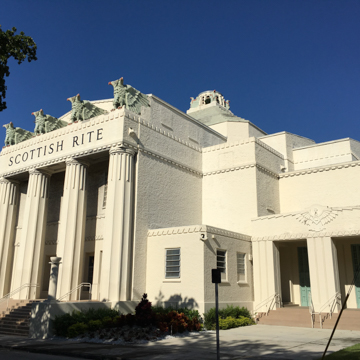Since its establishment in 1916, membership in the Miami Scottish Rite of Freemasonry grew rapidly, boasting 2,200 members in the 1920s. To accommodate the growing organization, in January 1922 drawings were unveiled and the first funds raised for a new Scottish Rite building, hailed at the time to be “one of the most imposing structures in the south.” The building, by architects Kiehnel and Elliott of Pittsburgh and Miami, was designed around a large auditorium and an enormous stage fronted by a colonnade and foyer. Large lodge rooms, a library, and offices were located on the first floor of the building, which was constructed with the latest in ventilation and fireproof technologies. At the ceremonial laying of the cornerstone, on December 8, 1922, William Jennings Bryan gave a formal address in which he mentioned that building was to “supply one of Miami’s greatest needs, an assembly hall adequate for the state and national meetings which will in increasing numbers be held here.”
Originally designated for a tract of land in Fort Dallas Park, which was later exchanged for the current tract on North River Drive, the structure was as much a symbol of civic pride as an important gathering space. The three-story masonry structure features four, two-story-high Doric columns on its principal (Third Street) facade. Crowning the intersection of the T-shaped building is a ziggurat-shaped roof topped by a cupola. This pyramidal roof, a reference to the mausoleum of Halicarnassus, is also employed at the slightly later Dade County Courthouse [FL-01-086-0048].
At the time, the Masonic Temple was thought to echo the aura of the “temples of ancient Greece and the pyramids and sphynxes of Egypt” with references to the “ancient Syrian, Egyptian, and Greek classical lines.” Its design has been referred to as an early example of Art Deco, particularly in its abstracted and stylized Egyptian and classical references. More specific symbolism in the building, however, points to the Scottish Rite and the Masons. The principal facade, for example, is designed around the number 32, which stands for 32 degrees, one of the highest levels of attainment for a Master Mason. The massive concrete columns rise thirty-two feet to support an entablature (reading “Scottish Rite”) upon which rest four double eagles, each with the number “32” carved between the heads.
A set of masonry steps leads into the building, which contains an auditorium with a seating capacity of 1,200. Two large balconies and two small balconies line the upper perimeter of the main floor. A large chandelier suspends from the dome below the ziggurat roof.
Over the years, the building served its intended purpose as a public space and local monument, although membership declined during the Depression years. The building served as the site of the 1930s Works Progress Administration’s Federal Theater Project and as an air raid shelter during World War II. Still in use by the Masons, the structure is regarded today as one of the most remarkable historic buildings in South Florida.
References
“Architecture Along Classic Lines and Steel and Concrete materials to Make Proposed Edifice Among Most Beautiful and Lasting Buildings in the South.” The Miami Herald, September 3, 1922.
Imposing Structure of Classical Lines to Take Its Place Among Best in South.” The Miami Herald, January 9, 1922.
Nepomechie, Marilys. Building Paradise: An Architectural Guide to the Magic City.Miami, FL: AIA Miami, 2010.
“The Scottish Rite Cathedral and Members of the Grand Lodge of Florida.” The Miami Herald, December 8, 1922.
“Valley Info.” Miami Scottish Rite. Accessed August 1, 2018. https://www.srmiami.org/.

